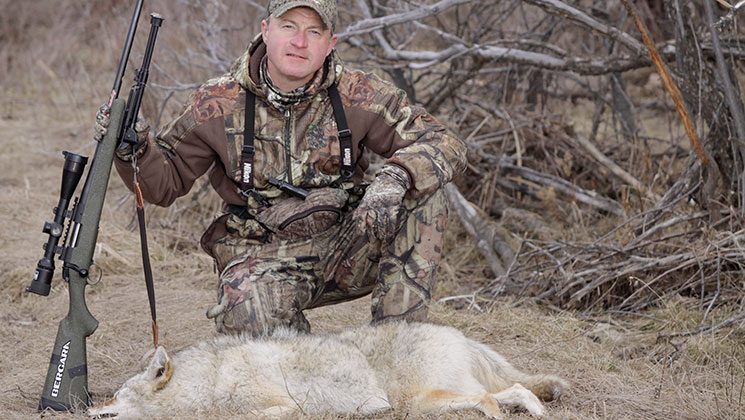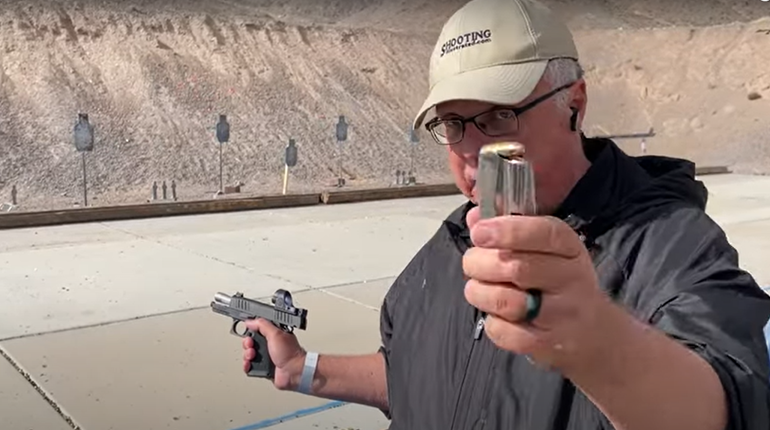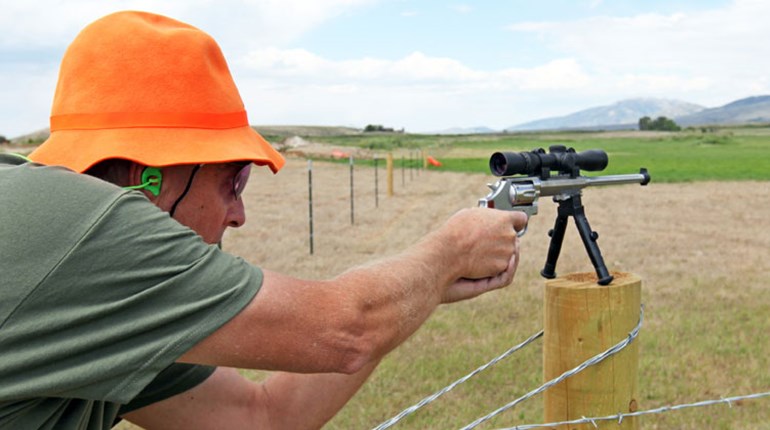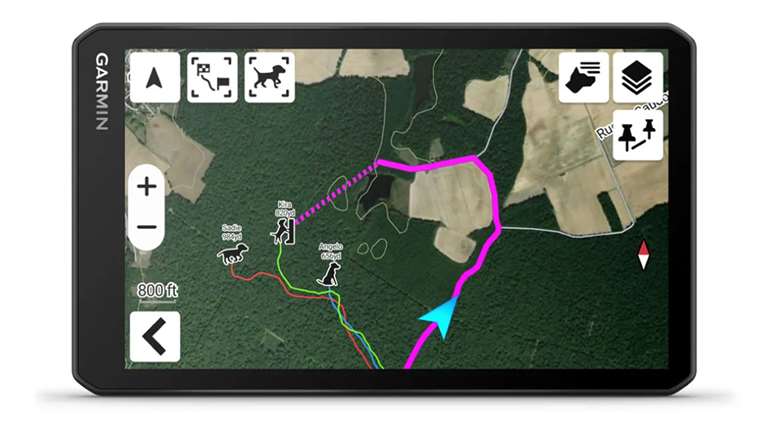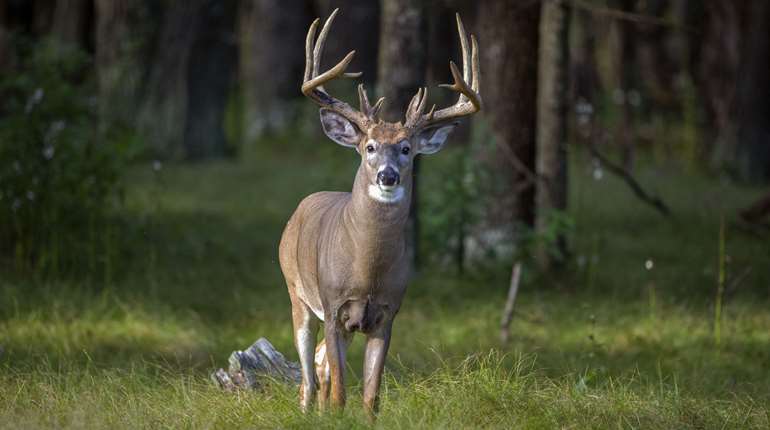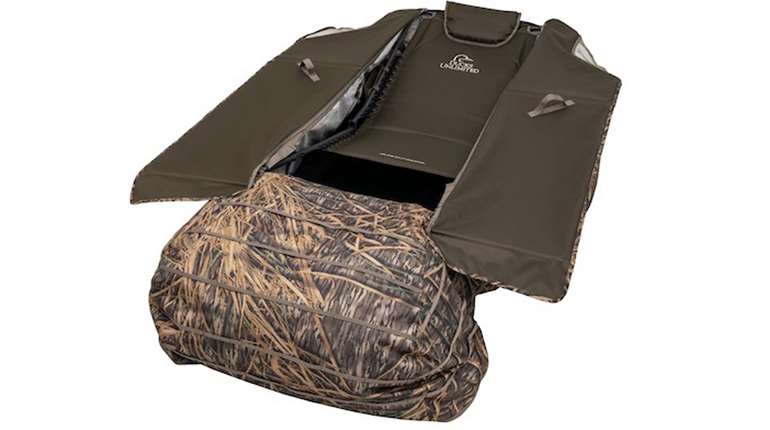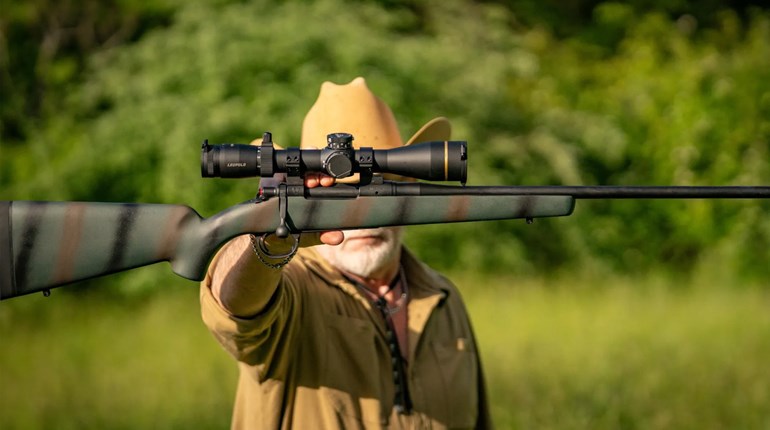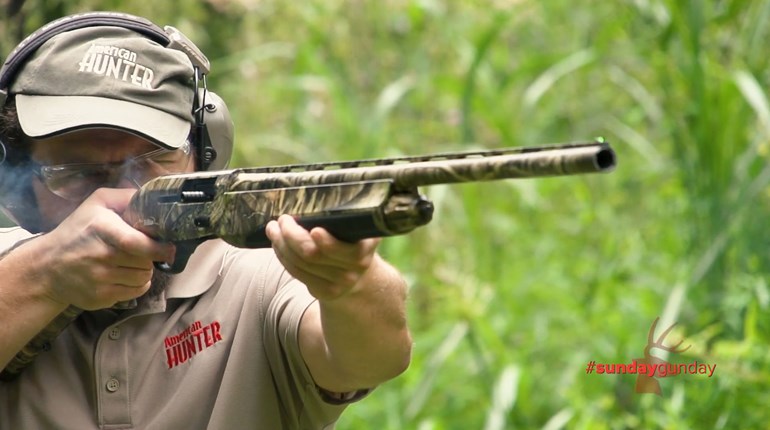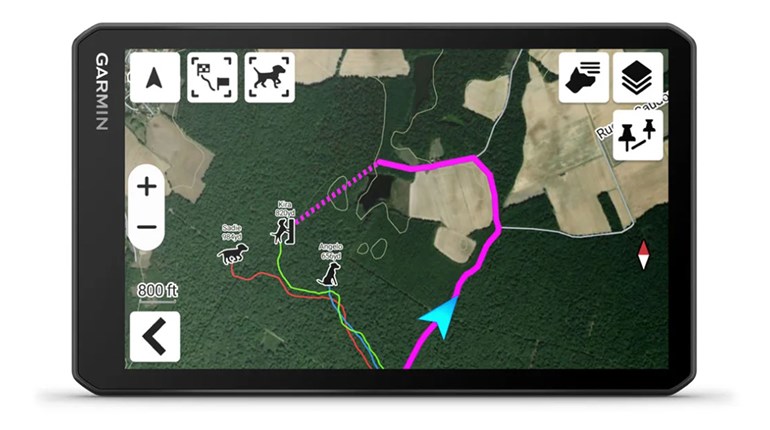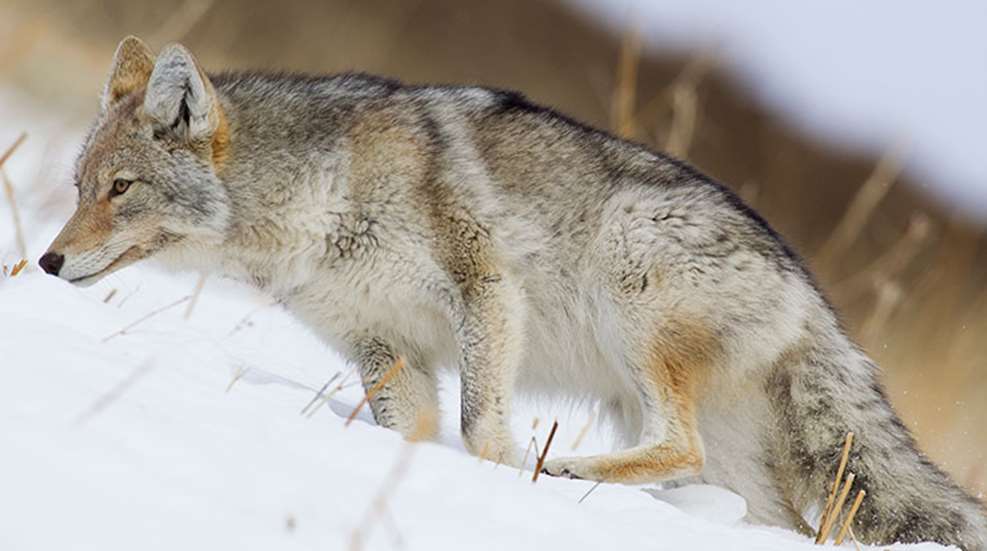
Something had to change and it was clearly up to me. Two weekends in a row coyotes had given me the proverbial cold shoulder. Rabbit-in-distress calls produced nothing more than hunts in distress. As I trudged through the snow in complete darkness to a weekend-warrior stand, my mind labored trying to craft a new plan of attack. Reaching a high point over a snow-covered valley, I settled in for the setup and settled on simply using lone howls. Maybe, just maybe these call-shy coyotes would venture close out of curiosity instead of shunning me, as Hollywood shuns firearm-passionate celebrities.
I howled with reservation and then set up surveillance in silence, hoping the initial calls would spark the interest of coyotes within earshot. Twenty-two minutes into the setup my questions were answered as a gray form appeared on a far ridge. My heart raced as I gripped my bipod-steady rifle. After the ridgetop pause, the coyote was again on the move. As suspected, his path started a wide circle downwind, but it was already within range and when he paused to sniff a bush I calmed myself enough to plant a V-Max on the coyote’s chest.
Since that shift years ago in my calling, I’ve routinely moved from prey-in-jeopardy to Curious George sounds in an attempt to trick pressured coyotes. Don’t kid yourself: Interest in predator hunting is at an all-time high. This interest has overtaken entire sections of sporting-goods stores and the marketing focus of firearm and ammunition manufacturers alike. Flip open a Cabela’s catalog to verify that statement. This uptick means you’ll likely experience coyote snubbing as well.
Randy Roede has spent more than 40 years hunting predators, and he’s done so professionally for the past 14 years as a wildlife damage specialist for South Dakota Game, Fish and Parks. His view from behind the barrel as a hired gun is clear: Coyotes are not as easy to kill with the increased focus on the sport.
“It’s getting harder and harder to call coyotes because everyone is doing it,” states Roede. “I judge just about all the calling contests around my area and usually you see contestants with pups from the previous spring. They’re not shooting as many big coyotes, and that means those older coyotes are not falling for the calls.”
Other hunting groups have similar experiences as more hunters target a species, especially with a focus toward calling. Turkeys and elk are two perfect examples. Turkeys and elk learn quickly that appealing calls don’t always equal the reflected message. Roede is quick to point out that low fur prices and plummeting numbers of trappers add to longer coyote survival rates, in addition to the education they receive from a larger pool of hunters. Craftier coyotes with a longer lifespan may also equal more focus on certain food sources. In the past five years, Roede has seen coyotes begin to concentrate on spring fawns and even pursue adult deer, and pronghorns.
“As the average age of the coyote population increases, they get another year of hunting experience through the fawning season,” Roede says. “They learn that a certain food source is around and target it.”
The negative, nationwide effect of coyotes on the deer population is a topic worthy of a separate manuscript. Nevertheless, if you hope to help in the fight and increase your coyote take it may be time to adjust your calls from perilous cries to calming curiosity. Curiosity can kill a coyote just as easily as it can ruin any cat’s day.
Howdy, Neighbor
Montanan Matt Piippo, the head pro staff manager for Les Johnson’s Predator Quest, has been pursuing coyotes with passion for more than a dozen years. He concurs with Roede regarding hunting pressure and points to the ease of calling with electronic callers as another reason for the increase in predator interest. “It’s just simpler,” he notes.
Piippo recalls the days when he could simply scream on a jackrabbit call and have coyotes run to the call at full speed. Those experiences are now memories. Successful hunters must evolve, he says. For him that meant trying new sounds. Now, when he knows he’s hunting educated coyotes, he relies on coyote vocalizations to spark a curious response.
“If I feel like an area has been pressured, I’m almost 100 percent vocalization,” states Piippo. “Most guys are simply not willing to use coyote vocalizations and not willing to learn what to say, and when to say it. It’s something coyotes hear every day and they’re not likely thinking about getting shot at when they travel to coyote sounds. They’re naturally a pack animal so they go looking for company or to kick out intruders. That’s why it works.”
You don’t need to major in coyote linguistics to put a message of curiosity into play. Piippo doesn’t engage in a sophisticated symposium of dialogue. He calls with a common-sense approach and envisions how coyotes converse in the real world to help him create a coyote scenario to spike curiosity.
“I typically start with a female lone howl,” he says. “I answer that with a male howl and then ramp it up with intensity like when a pair has found each other. You can create intensity with female and male challenge howls.”
After this banter Piippo will sit back and wait for a coyote to show up with prying eyes. How long to wait depends on your patience, but 30 minutes or more isn’t too long when putting vocalizations into play. For one added spark of enthusiasm, Piippo tosses in pups-in-distress early in the season or bickering-canines later in the season. The reason is simple.
“Ask yourself: When was the last time you heard a fight and stayed put?” questions Piippo. “Everyone wants to see a fight or get in it. That’s the curiosity factor. Older coyotes want to defend a territory and younger coyotes are battling for ground.”
Southern Missouri predator hunter Heath Wood has spent nearly two decades hunting coyotes in Ozark Mountain country. Wood, a pro staff member for Hunters Specialties, has also experienced the effect of calling popularity and its sinking effect on success. He also likes a good fight for arousing coyote interest and utilizes fighting calls from a variety of species to fool crafty coyotes. It works in the Ozarks and elsewhere.
“I like fighting sounds; coyotes will show up to a variety of animal fights,” Wood says. “I’ve had success with the sounds of coon and coyote fights, gray fox and coyotes, and even fights between redtail hawks and cottontails. There’s a good chance if there’s a fight going on, a coyote will show up regardless of the two species mixing it up.”
An Exotic Menu
Wood echoes Piippo’s advice on using coyote vocalizations if you suspect others have been calling with prey-distress, particularly rabbit-in-distress. When he wants to go even further into the curiosity continuum, Wood simply scans the endless sounds found on his Johnny Stewart electronic caller library. He’s looking for sounds that will stimulate curiosity, possibly hint at a meal, but not raise awareness levels of local coyotes.
“Every time I glance through the sound library,” admits Wood, “I’m amazed at how many ideas I come up with on sounds and sound combinations to try on pressured coyotes. And I always wonder, ‘Why didn’t I think of that sound to use when I hit a wall on a previous setup?’”
One category of sounds Wood has relied on surrounds nearly every hunting area: the sounds of farm and ranch. He visits with landowners routinely to see what’s going on—calving or possibly new additions to the herd. This gives him ideas on using sounds from anything to calf-in-distress, goats wailing, a hog-feeding hullabaloo or even the broadcast of barnyard kittens.
And as a turkey hunter, Wood has experienced his share of coyote-close encounters on setups. That and the stories of others have even helped him create a strategy incorporating the calls of turkeys combined with the sight of decoys. One of his ploys is to set a decoy at ground level then combine it with gobbler-in-distress calls. And if you haven’t mastered gobbler distress stick with simple yelps, fighting gobblers and other flock sounds for coyote consideration.
Piippo has done the same working with pheasant vocalizations, including the sound of a pheasant in trouble. When he realizes others have leaned hard on the sound of dying rabbits, he’s not afraid to freelance sounds; in his Zip code coyotes sniff out pheasants with capabilities that rival any seasoned pointer.
Dial down the squalls of any animal to moderate levels and you can cause coyotes to take notice instead of taking evasive action. Grunting porcupines and chirping prairie dogs have worked for me. And more than once I’ve used the simple squeaks of rodents to call coyotes over great distances on calm winter mornings. The message is dialed down one level below distress, yet imparts enough relevance to bring several mature coyotes into V-Max range.
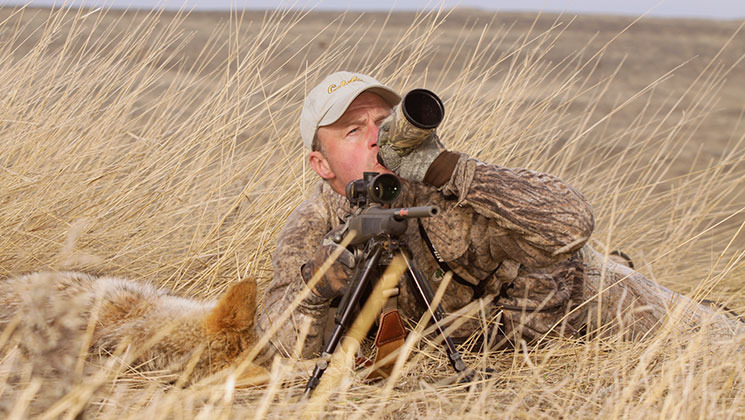
Polly Want a Cracker?
With the conversation switching to table- fare fowl like turkeys and pheasants, it’s important not to overlook the fact coyotes and aerial scavengers go together like politicians and kickbacks. You can’t have one without the other. Aerial scavengers include ravens, crows and the Western snoop, the magpie. You can also add the raucous members of the jay family that squawk predator alerts and also scavenge coyote leftovers. Regardless if these birds show up to broadcast a predator arrival alarm or snag a meal, the sounds of birds are a common denominator in the life of a coyote.
Do coyotes watch these birds for signs of approaching danger? Do coyotes feel more confident with the inflight surveillance? Nobody knows for sure, but the two oftentimes appear in tandem. What’s more, coyotes show little intolerance for the scavengers other than the occasional snap if the birds become too bold.
That noted, incorporating the sounds of birds into a setup has pros and very few cons. First, the sound of scavenger birds conversing is commonplace in a coyote’s world. Scavenger birds even follow coyotes throughout the day periodically to check for meal opportunities. That can arouse curiosity for coyotes hearing the clatter of crows or magpies wondering if a meal is nearby or if a visiting cousin is at the door.
You could also conclude that coyotes would feel confident with surveillance aloft and chatter continuing. Birds either stop their squawking when danger approaches or vamoose entirely. Keep your bird conversations at a modest pace and coyotes should think positive thoughts. If there is a con it’s the arrival of real birds. Be prepared. If the real McCoys spot you and sound the alarm, it could put coyotes back on alert.
Consider using the button on your caller that allows simultaneous sounds to run together. Pick a pair that correlates and you might spur a coyote investigation. You can mix coyote vocalizations with just about anything, but adding aerial scavengers such as crows is a real morale booster for coyotes.
I’ve even turned to solo ensembles with either crow calls or magpies when I feel coyotes are warier than my border collie eyeing an imminent bath. The setups certainly aren’t as productive as prey-distress on young-of-the-year coyotes, but on older coyotes I’ve landed the occasional old-timer investigating the safe sound. If I’m calling in an area I suspect has had little hunting pressure, I may include coyote vocalizations, a short distress sequence and then round out the setup with bird babble. If I see lots of truck tracks and clues left by past hunters at public parking areas, I will drop the distress and go with a lone howl followed by birds. Recently I’ve even dropped the vocalizations and allowed the birds to rant alone.
Last winter I hunted a public parcel that was seeing more auto action than a suburban Walmart parking lot. I knew coyotes were present from scouting and hearing morning howls, so I hiked into the middle of the allotment and waited for dawn shooting light. Feeling confident I could spy a gray coyote in the murky light, I voiced several lone howls and waited five minutes. Nothing materialized, so I added sounds of a bickering magpie to the setup. Not surprisingly, a trio of the black-and-white corvids arrived, adding to the canyon-land disturbance. I shut off my caller and let the reality stars take center stage. Soon they abandoned their post and my watch indicated I was well past a 30-minute sit. That’s when I spied a coyote peeking over the sagebrush 150 yards away.
My dog Sage was standing ready for decoying duty, but my sixth sense said this coyote would simply disappear at the sight of another canine. As the coyote readjusted for a better look, its head went behind a large clump of sagebrush. I dropped prone and immediately shifted my Bergara for a bipod-steady shot, and seconds later sent an echoing boom down the valley. Later inspection confirmed a 2-year-old female. Curiosity killed that coyote. Curiosity can bring the same success to you when coyotes have shown a reluctance to respond to the tried-and-true.
